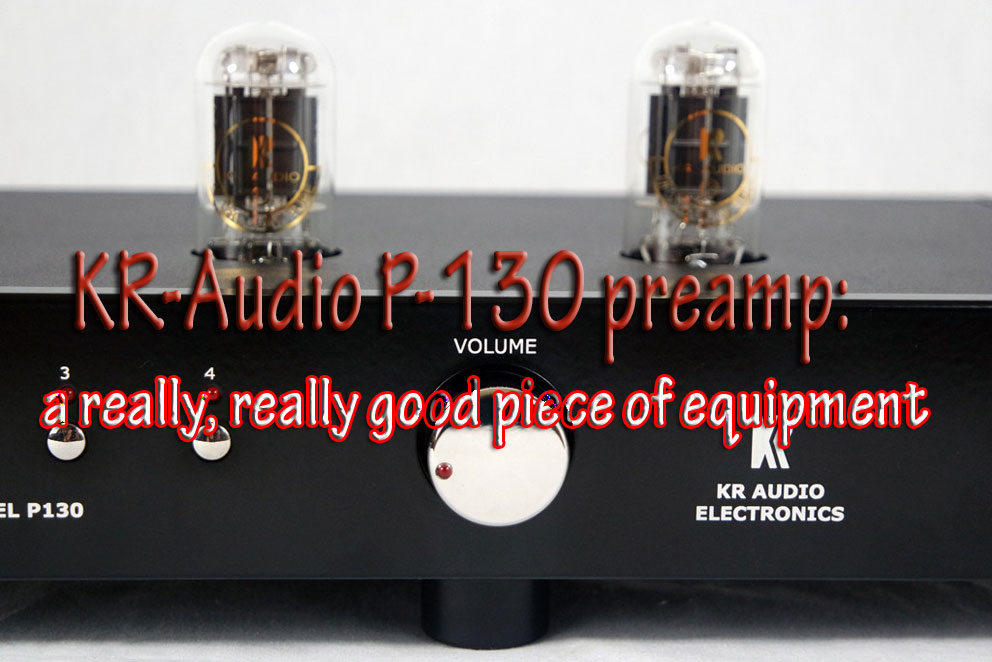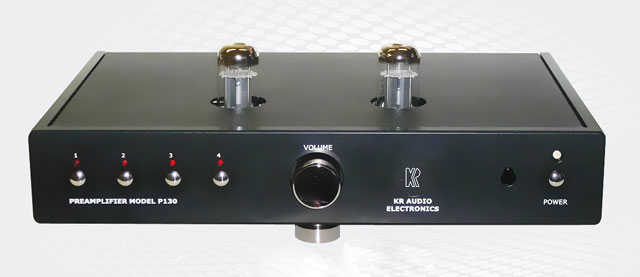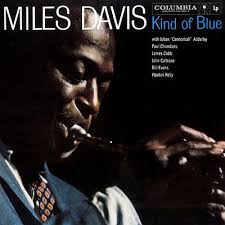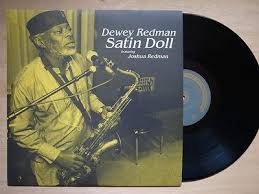KR Audio P-130 Preamplifier


A Brief, Completely Unnecessary Introduction
 It’s early-February here in Pittsburgh. We’re at the tail end range of the big east coast blizzard, and while we’re not going to get two feet of snow here, it’s enough that I’ll have to bust out the snow thrower for the driveway. It also means the furnace is running overtime: lots of hot dry, static inducing forced-air circulating aimlessly.
It’s early-February here in Pittsburgh. We’re at the tail end range of the big east coast blizzard, and while we’re not going to get two feet of snow here, it’s enough that I’ll have to bust out the snow thrower for the driveway. It also means the furnace is running overtime: lots of hot dry, static inducing forced-air circulating aimlessly.
You want to know what Ted Bundy felt when the State of Florida flipped the switch? Lay a finger on the tone arm lift. Feel the awesome power of a static discharge so strong it pops through the speakers like a gunshot. Dust and schmutz sails across the room from every direction to cling to freshly washed vinyl. In desperation I tried using the Milty Zero-Stat gun on my own socks. Horror of horrors: I’ve been forced to resort to digital as an emergency measure!
Oh, the humanity!

The KR Audio P-130 Preamplifier
KR Audio may be most recognizable as the manufacturer of enormous vacuum tubes, which they deploy in their own line of high-end power and integrated amplifiers. Manufactured in Prague, Czech Republic, their Kronzilla amplifiers are easy to spot with valves that are about the size of 1-liter pop bottles. They may very well be the largest tubes currently in production. I have not seen any larger.
Using single-ended circuits, the monster tubes allow KR’s amplifiers to produce real-world power in the 35- 200 watts a channel. That juice allows these amps to drive lower efficiency speaker loads, greatly expanding the consumer’s options among transducers in the popular 88-92 db sensitivity range, so ubiquitous in today’s market. They also make more traditional push-pull amps, one even using the very modern KT120 pentode, but the signature of their lineup is the big glass bottles.
As with most hi-fi exotica – and a company that manufactures its own proprietary tubes is certainly exotic – consumers pay a price for that unique engineering: with the big tubes we’re talking $20,000 integrated and $40,000 mono-block amplifiers. Rarified gear for a few lucky well-heeled audiophiles.

But tucked into their product array is a more down to earth piece of kit. Not as visually striking as the monster tubes, KR’s P-130 preamplifier with an optional built in MC phono stage is a trim chunk of hi-fi equipment: a simple black rectangular box with two tubes sticking up out of the top, measuring only 14x10x3 inches and weighing in at about 14 lbs. The P-130 has three single-ended and one balanced inputs, and one each single-ended and balanced outputs. My review sample included the optional phono-stage and I used only the RCA connections throughout the review.
Though not inexpensive, starting at $5,600 for a line-stage only version (add $800 for the MC phono stage), the P-130 is priced at least several thousand dollars less than almost anything else I could find in the KR line. It is also, as best I can tell, the only preamp in the KR line, suggesting that this is the preamp they use to drive all of their significantly more expensive amplifiers.
Densely compact, the P-130 has a high quality feel. The case is constructed of black aluminum plates that have been rounded over on the edges, softening both the look and the touch of the unit. The chromed controls for standby, volume and source selection have a firm, refined, positive action. LEDs indicate source, volume level and operating status, and there is even (Halleluiah!) a simple remote to select input and volume, something I’ve done without for years. As I get older I find myself pining away for these modern conveniences. Should we all really have to make a detour to turn the volume down on our way to answer the telephone?
The review sample did not come with any instructions or manual, which would be fine in a line-stage, but as I mentioned earlier this particular P-130 had the optional phono-stage, which was installed in the number-1 RCA input. For some reason this was not identified on either the faceplate or the rear jacks. The number-1 input is where I would ordinarily plug in my CD player, so it was fortunate that Alfred Kainz of importer High-End Electronics, Inc. mentioned it to me in an email, otherwise we might have gotten off to a bad start. Thanks!
Another unusual feature is that there is no ground screw for the phono cable. I did not attempt to attach the ground wire to any other devise during the review, nor did I experience any untoward noise or hum issues using my Audio-Technica OC-9 cartridge.
Other than that, setup is pretty simple: Plug the two KR-5 tubes into the top, hook up your sources and amp, hit the power main on the rear, the standby on the front, and you’re off to the races.
A Tale of Two Preamps
I am an unabashed tube lover. I love the warmth, the sonic glow, and the plump palpability of glass bottles. In audiophile vernacular I would stake a claim as an ‘As You Like It’ listener: First and foremost I like my music to sound fabulous, and I don’t give a damn about ultimate fidelity to the live event. When I get that visceral image of John Coltrane blowing his horn six feet in front of my face, why should I give a hoot whether the room he was playing in sounds rectangular or not?
Which isn’t to say that my system sounds bloated, indistinct or fuzzy: far from it. But it does have that warm richness often associated with tubes. The only thing in my system that doesn’t run on valves is my CD player, and if I had the technical skills to hot-wire a couple of 12ax7s in there, warranty be damned, I would be tempted to try it.
The combination of my Emotive Audio Poeta pre-amp and Cary power amp gives me a combination of tubey goodness as well as a high level of tonality, detail, and soundstage depth. Basses sound tight and woody, and the treble is smooth and free of glare without being rolled off. My only complaint with the combo is that the Poeta’s output is a little higher than ideal for V12. The result is that I’m only able to use the volume knob to about 10 o’clock (a little higher with vinyl), and there can be a very slight bit of hiss and hum that’s only audible if I stick my ear right up against the tweeters. Even this has been largely ameliorated by swapping out the factory 12BZ7 tubes for a lower gain 12AY7 – a trade sanctioned by Cary – which I’ve also found to be a smoother, better sounding tube overall.
Unfortunately, the Poeta does not have a phono-stage build in, so I’ve been using a humble Project Tube Box on the side. It’s not expensive or fancy, but it sounds a lot better than any component should for $300, especially with a pair of NOS Mullard 12AX7’s in it. I keep thinking I should upgrade it, but it sounds pretty darned good, so I’ve never bothered.
The P-130: Plug and Play and Sit Tight For a Bit
The Poeta preamp is the only controller I’ve had in my system for about five years and during that time I’d largely forgotten about extended component break in periods. Yes, the sound of individual amps and speakers I’ve had in for review changes subtly over the first few hours of play but, though audible, none of them was especially dramatic.
That was not the case with the P-130. In fact break-in on this preamp yielded the most pronounced sonic flowering of any component I’ve ever listened to in my house. Straight out of the box I was a little surprised that a fairly expensive component sounded so overly dark, with far less soundstage width than I’m accustomed to, and perhaps the least vertical imaging height I’ve ever heard from any piece of equipment in my home. Firing it up the first time, the kindest thing I could say about it was that it was extraordinarily unremarkable. I immediately yearned to re-install my Poeta thinking, ‘Oh, I’ll deal with that little black box some other time.’
Then a bit of laziness took over. I’d just rewired my system to install the P-130; my wife was calling for dinner; my three-year-old was bouncing around, and I just didn’t feel like messing with it all over again. So I left it installed, and I was quickly glad I had. The P-130 proved to be well worth my lack of effort (Let’s face it: I was slacking) as over the course of a few days it began to open up; after a week it sounded great, and it continued to improve over about a month. It blossomed like a rose.
Hear Ye! Hear Ye!
The very first review I wrote for Stereotimes was of my very same Poeta line-stage, and the KR P-130 is the first preamp I’ve had in for review since then, so it seemed fitting to revisit one of the same recordings I used for that first write-up.
 In that review I wrote that Tord Guftavson’s Being There (CD ECM 2007) had an enormous, deep soundstage, with essentially perfect reproduction of instrument timbres. I cited cymbals that revealed whether they were being tapped at the edge or close to the nut, and piano that, in addition to being properly large-scaled, revealed all those subtle tonal interactions that come with chords and pedal manipulations. It wasn’t as realistic as sitting in a room with Mom’s Steinway, obviously, but it really captured the essentials of the piano’s scale and subtleties.
In that review I wrote that Tord Guftavson’s Being There (CD ECM 2007) had an enormous, deep soundstage, with essentially perfect reproduction of instrument timbres. I cited cymbals that revealed whether they were being tapped at the edge or close to the nut, and piano that, in addition to being properly large-scaled, revealed all those subtle tonal interactions that come with chords and pedal manipulations. It wasn’t as realistic as sitting in a room with Mom’s Steinway, obviously, but it really captured the essentials of the piano’s scale and subtleties.
With the same recording, the KR P-130 offers many of the same qualities but with a little different emphasis. It has excellent clarity and detail, on par with my Poeta, and its also the more neutral and accurate of the two; the Poeta having a more – perhaps even slightly exaggerated – euphonic presentation. For a crude comparison, you might say the P-130 is a little more Audio Research than Shindo.
The P-130’s treble is well extended with no grating artifacts unless they’re in the recording, and the bass is cleaner if maybe not quite as deep as my own equipment.
The P-130 was also quieter than my preamp, and therefore – at first blush – it seemed to have better overall detail retrieval. It also presents excellent, natural instrument timbres, but again with a little less warmth and tubey glow. With a digital source that neutrality came with a hair of comparative dryness that – in my humble opinion – said more about the inherent qualities of my CD Player than about the P-130 itself. The dryness disappeared entirely with analog sources.
On the other hand, re-installing my own preamp firmly debunked my initial impression that the P-130 had better detail retrieval. Listening carefully I concluded that what I initially thought was obfuscation by the Poeta was more likely just an artifact of its darker presentation. As the challenger, the more illuminated soundstage of the P-130 definitely awarded it a few extra points.
The P-130 brings a different perspective and fewer biases than my own preamp, but it does so with a very high level of competence and musicality. I found effectively nothing to complain about with the P-130 and any differences between it and my own preamp came down to nothing more scientific than personal preference.
In the end, I am still very much enamored with my Poeta, but I could happily live with the KR Audio P-130 as well. It’ always a good sign for any equipment when the reviewer starts considering financial ramifications as he contemplates the best way to justify yet another major purchase to an already indulgent wife. The P-130 is a very enjoyable, very musical piece of hi-fi equipment.
A Tale of Two Phono-Stages
By far my favorite feature of the P-130 was it’s integrated phono stage. I haven’t had a built-in p-stage since I sold a Musical Fidelity Nu-Vista M3 almost a decade ago. The convenience is undeniable: avoid yet another expensive component, additional cables, tube swapping, etc. Nice and easy.
 But since I had my Project Tube Box phono stage handy I thought a direct back-to-back comparison with the P-130 would be interesting. There is no jazz record that’s been beaten like a dead horse more than Miles Davis’ Kind of Blue (Columbia 1959). This record has had so many ‘definitive’ reissues that ‘definitive’ might as well mean ordinary, un-noteworthy, or commonplace. Great record, but I’ve lost track of how many hundreds of times I’ve listened to it and on how many different releases.
But since I had my Project Tube Box phono stage handy I thought a direct back-to-back comparison with the P-130 would be interesting. There is no jazz record that’s been beaten like a dead horse more than Miles Davis’ Kind of Blue (Columbia 1959). This record has had so many ‘definitive’ reissues that ‘definitive’ might as well mean ordinary, un-noteworthy, or commonplace. Great record, but I’ve lost track of how many hundreds of times I’ve listened to it and on how many different releases.
Kind of Blue’s ubiquity is also what makes it a great record to use for reviewing hi-fi equipment. Let’s face it: there may be a few Stereo Times readers out there who haven’t heard this record, but I’d wager not many. Most of us do know the record, and more importantly, what it sounds like. That familiarity makes it good for comparing gear.
 In a timely coincidence, Mobile Fidelity Sound Labs actually managed to pour some life back into this mare with a new 45 RPM, two record, boxed set that was released late last year, just in time for my wife to snag me a copy for Christmas. The vinyl is pristine, the sound quality really is better than any other version I have, and it comes in a lovely box with a full size booklet of pictures and notes.
In a timely coincidence, Mobile Fidelity Sound Labs actually managed to pour some life back into this mare with a new 45 RPM, two record, boxed set that was released late last year, just in time for my wife to snag me a copy for Christmas. The vinyl is pristine, the sound quality really is better than any other version I have, and it comes in a lovely box with a full size booklet of pictures and notes.
Turns out that there was a little get-up-and-go in this old nag after all. Who knew?
For this test, I plugged my evergreen Tube Box into an unused line-level input on the P-130 so I could do a direct back-to-back comparison by simply switching the RCA lines from the built in stage to the outboard unit.
I’m pretty happy with the Project when connected to my own line-stage, but it proved not to be a happy match with the P-130’s line level input. The Tube Box has less output gain than the built-in stage, requiring me to really crank up the volume knob to achieve parity. Connected to the P-130, the Project was less detailed, had a little less grip on instrument textures – particularly on the piano, and a much, much darker soundstage. There were also a few passages where instruments sounded slightly crowded around the speakers instead of spread out between them. It doesn’t sound bad, per se, it just didn’t capture as much information as the P-130’s built in phono-stage.
By comparison, the P-130’s phono stage was terrific, not just against the Tube Box, but in its own right. This is a well-done phono-stage that was definitely not a design afterthought.
In general, very much like the P-130’s line-stage inputs, I found the phono-stage to be very natural sounding with a nicely illuminated soundstage, a large stereo image, great detail, and an overall presentation that was hard to fault without unnecessarily splitting hairs. If this was the only phono stage I ever had in my house I could be very happy for a very long time.
The MoFi Kind of Blue pressing reduces (slightly) the hard left-right panning of other versions of this record I’ve listened to. This leaves the musicians a little more naturally arranged in space. The horns retain that visceral grip, and Bill Evans’ piano sounds a little less compressed. The P-130 delivers all of that with aplomb.
I’ve seen some reviews that have been critical of this particular reissue because the authors felt that the bass had been boosted in the remastering, and it does seem more pronounced. Regardless of whether it was enhanced (Oh, say it ain’t so!) or not, it’s still good bass. That is: it’s deep, tight and woody without sounding bloated or mushy. The P-130 did a good job of conveying the weight and tonality of the bottom end.
 Another record I’ve had in heavy rotation recently is the late Dewey Redman’s Satin Doll, (LP Venus 1998) which also features Dewey’s son Joshua Redman. This particular pressing is a Japanese 180G copy* and it’s a beautiful recording. It’s a little unusual for a Dewey Redman record because it features a lot of standards with essentially straight-ahead playing. Not too many flights of avant-garde creative fancy here, but a terrific album none-the-less.
Another record I’ve had in heavy rotation recently is the late Dewey Redman’s Satin Doll, (LP Venus 1998) which also features Dewey’s son Joshua Redman. This particular pressing is a Japanese 180G copy* and it’s a beautiful recording. It’s a little unusual for a Dewey Redman record because it features a lot of standards with essentially straight-ahead playing. Not too many flights of avant-garde creative fancy here, but a terrific album none-the-less.
Comparing the phono-stages with the Redman record left me with effectively the same conclusions. The P-130 sounded more open, with better illumination and detail. The soundstage with the Project seemed diminished in comparison.
BUT, switching the Tube Box back to the Poeta erased much of – though not quite all of – the advantage of the P-130’s built in stage. The Tube Box does play really well with the Poeta. The soundstage of the P-130 still had better overall illumination. After spending a considerable amount of time with to the P-130 and its built in phono-stage, I wished that the Poeta had one of its own too.
It’s also worth mentioning that the the P-130’s built in phono-stage was a really strong pairing with my Audio-Technica OC-9II cartridge. But given the varied loading requirements of different moving-coil pickups, careful attention to matching with this pre-amp would be required. Some technical specs provided in a user’s manual would be helpful for this.
Then there’s the shear convenience of the thing: Somewhere along the way audiophiles convinced themselves that separating every component into more and more boxes with more and more commensurately expensive interconnecting cables made everything sound better. Needless to say, equipment manufacturers have been only too happy to oblige. The P-130 with its high quality built in phono-stage makes a strong case for how idiotic that position can be. This is a great sounding line-stage with an equally great sounding phono-stage built in: an affordable upgrade with no extra boxes, no extra wires, and really great sound. It’s hard to go wrong with a thing like this.
Conclusions
I hope it’s apparent that I was really impressed with the KR Audio P-130 preamplifier. It’s simple to set up, simple to use, and it’s built to a very high quality standard. It was an excellent match for my amplifier and – while it emphasized slightly different qualities than my own preamp – its overall sound was hard to challenge. It’s not inexpensive, but by today’s standards it does represent a decent value. Assuming the internal workings are as robust as the exterior casework, this could be a great foundation piece for any system for a very long time. The KR-Audio P-130 preamp is a really, really good piece of equipment. Highly recommended.


greg simmons
Notes
*Discogs lists this Japanese copy as the only release of this record, recorded in 1992 and released in 1998. No CD has been issued that I could find and it’s not available on iTunes. Definitely worth seeking out though.
Specifications:
– Unity Gain Preamplifier with optional phono stage.
– Aluminum casework
– Tubes: two KR-5
– Bandwidth: 10Hz – 100kHz (-3dB)
– Output Impedance: 2k Ohms
– Input 1V RMS / 47kOhms
– Standard IEC power cord connection
– Three single ended inputs, one balanced input
– One each balanced and single-ended outputs
– Built in phono-stage
Price: $5,600 plus $800 optional phono stage.
Distributor: Highend-electronics, Inc.
Alfred Kainz
19593 Roanoke Road
Apple Valley, CA 92307
Phone: 760-490-2410
Fax: 760-242-1065
Website: http://highend-electronics.com/
Email: office@highend-electronics.com
Stereo Times Masthead
Publisher/Founder
Clement Perry
Editor
Dave Thomas
Senior Editors
Frank Alles, Mike Girardi, Russell Lichter, Terry London, Moreno Mitchell, Paul Szabady, Bill Wells, Mike Wright, and Stephen Yan,
Current Contributors
David Abramson, Tim Barrall, Dave Allison, Ron Cook, Lewis Dardick, John Hoffman, Dan Secula, Don Shaulis, Greg Simmons, Eric Teh, Greg Voth, Richard Willie, Ed Van Winkle, Rob Dockery, Richard Doron, and Daveed Turek
Site Management Clement Perry
Ad Designer: Martin Perry





Be the first to comment on: KR Audio P-130 Preamplifier